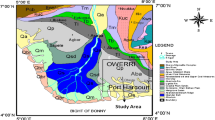Abstract
Amplitude versus offset (AVO) contains abundant information of sediment elastic properties. Some of these properties are sensitive to the saturation of gas hydrate or free gas accumulated in the sediments. Here, AVO inversion is performed to the seismic data of Shenhu Area, South China Sea. Based on the accurate Zoeppritz equation, P wave velocity and S wave velocity are obtained. Based on elastic impedance equation, P wave impedance, S wave impedance, and fluid factor are obtained. The inverted elastic parameters show that there are gas hydrate and free gas in this area. Moreover, the conception of elastic parameters relative variation rates was proposed and applied here, and the results show that they can be used to identify the top of gas hydrate zone.











Similar content being viewed by others
References
Andreassen K, Hart PE, MacKay M (1997) Amplitude versus offset modeling of the bottom simulating reflection associated with submarine gas hydrates. Mar Geol 137(1):25–40
Connolly P (1999) Elastic Impedance. Lead Edge 18(4):438–452
Diaconescu CC, Kieckhefer RM, Knapp JH (2001) Geophysical evidence for gas hydrates in the deep water of the South Caspian Basin, Azerbaijan. Mar Pet Geol 18:209–221
Ecker C, Nur A, Dvorkin J (1998) Sediments with gas hydrates: internal structure from seismic AVO. Geophysics 65(5):1659–1669
Kvenvolden KA (1993) Gas hydrate-geological perspective and global change. Rev Geophys 31(2):173–187
Lee MW, Waite WF (2008) Estimating pore-space gas hydrate saturations from well log well log acoustic data. Geochem Geophys Geosyst 9:7
Lee MW, Collett TS, Lewis KA (2012) Anisotropic models to account for large borehole washouts to estimate gas hydrate saturations in the Gulf of Mexico Gas Hydrate Joint Industry Project LegII Alaminos Canyon 21 B well. Mar Pet Geol 35:85–95
Li W, Yu XH, Zeng XM, Wang JZ, Shan X (2013) Study of neogene seismic and sedimentary facies in the hydrate survey area of Shenhu Region on the north margin of South China Sea. Mar Geol Front 29(1):18–25
Liang J, Wang MJ, Lu JA, Liang JQ, Wang HB, Kuang ZG (2013) Characteristics of sonic and seismic velocities of gas hydrate bearing sediments in the Shenhu area, northern South China Sea. Nat Gas Ind 33(7):29–35
Liu YG, Liu XG, Liu DM, Wang YJ, Yan J, Zhao YX (2008) Applications of seismic techniques to gas hydrates prediction. Appl Geophys 5(1):67–73
Lu SM, George M (2016) Elastic impedance inversion of multi-channel seismic data to detect gas hydrate and free-gas. Seg Technical Program Expanded Abstracts 21(1):2478
Lu S, McMechan GA (2002) Estimation of gas hydrate and free gas saturation, concentration, and distribution from seismic data. Geophysics 67:582–593
Riedel MG, Bellefleur M, Stephanie A, Thomas B, Scott R, Dallimore (2009) Acoustic impedance inversion and seismic reflection continuity analysis for delineating gas hydrate resources near the Mallik research sites, Mackenzie Delta, Northwest Territories, Canada. Geophysics 74(5):B125–B137
Sha ZB, Gong YH, Liang JQ (2006) How to judge gas hydrates seismic characteristic from the different kinds of attribute profile. Geol Res South China Sea I:105–113
Shipley TH, Houston MH, Buller RT, Shaub FJ, McMillen KJ, Ladd JW (1979) Seismic reflection evidence for widespread occurrence of possible gas-hydrate horizons on continental slopes and rises. AAPG Bull 63:2204–2213
Singh SC, Minshull TA, Spence GD (1993) Velocity structure of a gas hydrate reflector. Sci Geophys 260:204–207
Su M, Yang R, Wu NY, Wang HB (2014) Structural characteristics in the Shenhu Area, northern continental slope of South China Sea, and their influences on gas hydrate. Geojournals 88(3):319–325
Tinivella U (1999) A method for estimating gas hydrate and free gas concentrations in marine sediments. Boll Geofis Teor Appl 40(1):19–30
Wu S, Zhang G, Huang Y, Liang J, Wong HK (2005) Gas hydrate occurrence on the continental slope of the northern South China Sea. Mar Pet Geol 22:403–412
Wu NY, Yang SX, Wang HB, Liang J, Gong YH, Lu ZQ, Wu DD, Guan HX (2009) Gas-bearing fluid influx sub-system for gas hydrate geological system in Shenhu Area, Northern South China Sea. Chin J Geophys 52(6):1641–1650
Yuan T, Nahar KS, Roop C (1998) Marine gas hydrate: seismic observations of bottom simulating reflectors off the west coast of Canada and the east of India. Geohorizons 3(1):235–239
Yuan T, Spence GD, Hyndman RD, Minshull TA, Singh SC (1999) Seismic velocity studies of a gas hydrate bottom-simulating reflector on the northern Cascadia continental margin: amplitude modeling and full waveform inversion. J Geophys 104:1179–1191
Zhang RW, Li HQ, Zhang BJ, Huang HD, Wen PF (2015) Detection of gas hydrate sediments using prestack seismic AVA inversion. Appl Geophys 12(3):453–464
Funding
This research was funded by the National Key Research and Development Program of China (2017YFC0307405), the NSFC-Shandong Joint Fund for Marine Science Research Centers (U1606401), and the China Geological Survey Project (grant number 201100307).
Author information
Authors and Affiliations
Corresponding author
Rights and permissions
About this article
Cite this article
Wang, X., Pan, D., Wu, Z. et al. Gas hydrate elastic properties inversion by AVO Technology in Shenhu Area of the South China Sea. Arab J Geosci 11, 546 (2018). https://doi.org/10.1007/s12517-018-3888-5
Received:
Accepted:
Published:
DOI: https://doi.org/10.1007/s12517-018-3888-5




